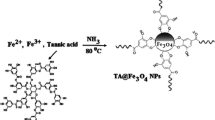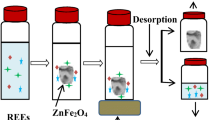Abstract
Bare (unmodified) and crown ether (CE)-modified Fe3O4 magnetic nanoparticles (MNPs) were investigated for the rapid extraction of 226Ra from water samples. It involved synthesizing the MNPs, introducing them into the sample solutions, ultrasonicating and agitating the suspension, magnetically separating the nanoparticles from solution, and measuring the 226Ra content in the supernatant. Experimental parameters such as salt choice, salt concentration and pH were optimized to achieve maximum extraction of 226Ra onto the MNPs. 226Ra content was determined using a Hidex 300SL liquid scintillation counter with α/β separation capability, or a gamma spectrometric detection system. The bare Fe3O4 nanoparticles showed significant pH dependence for the extraction of 226Ra from an aqueous solution over a pH range of 2–10. They gave an extraction of 95 ± 1 and 98 ± 1 % at pH 9 in 0.1 M NaCl and 0.1 M NaClO4, respectively, whereas an extraction of 8–24 % was obtained, over the pH ranges from 2 to 5. The CE-modified MNPs yielded extraction efficiencies as high as 99 ± 1 % in the presence of 0.01 M picric acid at pH 4. This study demonstrates that the surface functionalization of Fe3O4 MNPs with suitable ligand modification can offer a selective mode of extraction for 226Ra in the presence of its daughter progenies.









Similar content being viewed by others
References
Faraji M, Yamini Y, Rezaee M (2010) Magnetic nanoparticles: synthesis, stabilization, functionalization, characterization, and applications. Tehran, Iran. J Iran Chem Soc 7(1):1–37
Gao J, Gu H, Xu B (2009) Multifunctional magnetic nanoparticles: design, synthesis, and biomedical applications. Acc Chem Res 42(8):1097–1107
Vatta LL, Sanderson RD, Koch KR (2006) Magnetic nanoparticles: properties and potential applications. Pure Appl Chem 78(9):1793–1801
Beveridge JS, Stephens JR, Williams ME (2011) The use of magnetic nanoparticles in analytical chemistry. Annu Rev Anal Chem 4:251–273
Kumar C (2009) Magnetic Nanomaterials. Wiley, Weinheim
O’Hara MJ et al (2011) Investigation of magnetic nanoparticles for the rapid extraction and assay of alpha-emitting radionuclides from urine: demonstration of a novel radiobioassay method. Health Phys 101:196–208
Varve Z, Lai EPC, Li C, Sadi BB, Kramer GH (2012) Polymer coated magnetic nanoparticles for rapid bioassay of 90Sr in human urine samples. J Radioanal Nucl Chem 292:1411–1415
International Atomic Energy Agency, Analytical methodology for the determination of radioisotopes in environmental samples. http://nucleus.iaea.org/rpst/ReferenceProducts/Analytical_Methods/AQ-19.pdf. Accessed 30 Oct 2012
Medley P et al (2005) Barium sulphate method for radium-226 analysis by alpha spectrometry, Australia, unpublished paper. Internal report, p 501
Chu T-C, Lin C-C (2001) The solvent extraction of radium using sym-Di[4(5)-tert-butylbenzo]-16-crown-5-oxyacetic acid. App Radiat Isot 55(5):609–616
Beklemishev MK, Elshani S, Wai CM (1994) Solvent extraction of radium with crown ether carboxylic acids. Anal Chem 66:3521–3524
McDowell WJ, Arndsten BA, Case GN (1989) The synergistic solvent extraction of radium from alkaline nitrate media by dicyclohexano-21-crown-7 combined with 2-methyl-2-heptyl nonanoic acid equilibrium reactions and metal ion competition. Solvent Extr Ion Exch 7:377–393
Dai X, Kramer-Tremblay S, Li C (2012) Rapid determination of 226Ra in urine samples. Radiat Prot Dosimetry 151(1):1–6
Aharmim B, Cleveland BT, Dai X, Doucas G, Farine J, Fergani H, Ford R, Hahn RL, Hallman ED, Jelley NA, Lange R, Majerus S, Mifflin C, Noble AJ, O’Keeffe HM, Rodriguez-Jimenez R, Sinclair D, Yeh M (2009) High sensitivity measurement of 224Ra and 226Ra in water with an improved hydrous titanium oxide technique at the sudbury neutrino observatory. Nucl Instrum Methods Phys Res Sect A 604(3):531–535
Maxwell SL III (2006) Rapid method for 226Ra and 228Ra analysis in water samples. J Radioanal Nucl Chem 270:651–655
Moon DS, Burnett WC, Nour S, Horwitz P, Bond A (2003) Preconcentration of radium isotopes from natural waters using MnO2 resin. Appl Radiat Isot 59:255–262
Purkl S, Eisenhauer A (2003) Solid-phase extraction using Empore™ radium rad disks to separate radium from thorium. J Radianal Nucl Chem 256:473–480
Seely DC, Osterheim JA (1998) Radiochemical analyses using Empore™ disk technology. J Radioanal Nucl Chem 236(1–2):175–180
Durecova A (1997) Contribution to the simultaneous determination of 228Ra and 226Ra by using 3 M’s Emopre™ radium rad disks. J Radioanal Nucl Chem 223(1–2):225–228
Lariviere D, Epov VN, Reiber KM, Cornett RJ, Evans RD (2005) Micro-extraction procedures for the determination of Ra-226 in well waters by SF-ICP-MS. Anal Chim Acta 528:175–182
Joannon S, Pin C (2011) Ultra-trace determination of 226Ra in thermal waters by high sensitivity quadrupole ICP-mass spectrometry following selective extraction and concentration using radium-specific membrane disks. J Anal At Spectrom 16:32–37
Chiarizia R, Dietz ML, Horowitz EP, Burnett WC, Cable PH (1999) Radium separation through complexation by aqueous crown ethers and ion exchange or solvent extraction. Sep Sci Technol 6 and 7(34):931–950
Sadi B et al (2011) Rapid determination of Ra-226 in water samples using dispersive liquid–liquid microextraction coupled with liquid scintillation counting. J Radianal Nucl Chem 290:215–425
van Leewen FWB, Verboom W, Reinhoudt DN (2005) Selective extraction of naturally occuring radioactive Ra2+. Chem Soc Rev 34:753–761
Wei Wu, He Q, Jiang C (2008) Magnetic iron oxide nanoparticles: synthesis and surface functionalization strategies. Nanoscale Res Lett 3:397–415
Nechifor AC, Stoian MG, Voicu SI, Nechifor G (2010) Modified Fe3O4 colloidal dispersed magnetic particles as carrier in liquid membranes. Optoelectron Adv Mater Rapid Commun 4(8):1118–1123
Kawamura M, Sato K (2007) Magnetic nanoparticles-supported crown ethers. Chem Commun 28(32):3404–3405
McCarthy SA, Davies G-L, Gun’ko YK (2012) Preparation of multifunctional nanoparticles and their assemblies. Nat Protoc 7(9):1677–1693
Hrdina A, Lai E, Li C, Sadi B, Kramer G (2011) Preliminary studies of an 18-crown-6 ether modified magnetic cation exchange polymer in rapid 90Sr bioassay. Health Phys 101:187–195
Fatah Dr Alim A et al (2007) Guide for the selection of chemical, biological, radiological, and nuclear (CBRN) decontamination equipment for emergency first responders U.S. Department of Homeland Security, http://www.nist.gov/customcf/get_pdf.cfm?pub_id=911304, Accessed 10 10 2012
Sadi BB, Li C, Kramer HG (2011) An emergency radiobioassay method for 226Ra in human urine sample. Radiat Prot Dosimetry 151(1):1–7
Health Canada (2009) Health Canada guidelines for Canadian drinking water Quality. Health Canada, Ottawa
McAlister DR, Horwitz EP (2011) Radium separation method: crown ether extraction from dilute perchloric acid. Radiobioassay & Radiation Measurements Conference (RRMC)
Philip Horwitz E, Chiarizia R, Dietz ML (1992) A novel strontium-selective extraction chromatographic resin. Solvent Extr Ion Exch 10(2):313–336
Chuang JT, Lo JG (1995) The solvent extraction of carrier-free 90Y from 90Sr with crown ethers. J Radioanal Nucl Chem 189:307–317
Lai EPC, Bahraini N, Li C, Sadi BB, Kramer GH (2012) Cd2+, Cu2+, Pb2+, Sr2+, and Y3+ binding characteristics of 17β-estradiol molecularly imprinted polymer particles incorporated with dicyclohexano-18-crown-6 for urine bioassay. J Appl Polym Sci 123(1):12–19
Acknowledgments
Financial support from NSERC Canada and Health Canada (Radiation Protection Bureau, Ottawa, ON) is gratefully acknowledged.
Author information
Authors and Affiliations
Corresponding author
Rights and permissions
About this article
Cite this article
Mesnic, N., Sadi, B., Li, C. et al. Application of magnetic nanoparticles for the extraction of radium-226 from water samples. J Radioanal Nucl Chem 298, 1501–1509 (2013). https://doi.org/10.1007/s10967-013-2604-x
Received:
Published:
Issue Date:
DOI: https://doi.org/10.1007/s10967-013-2604-x




